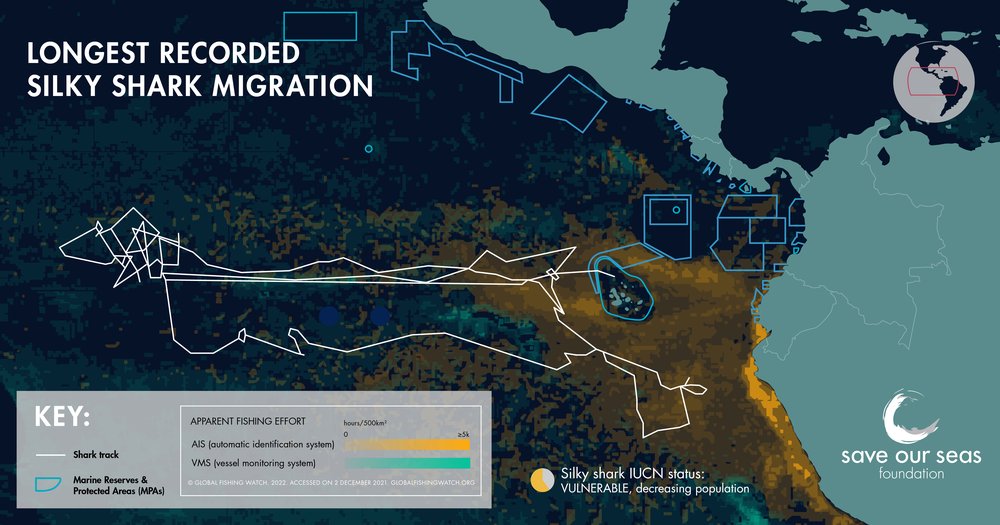Silky shark's record-breaking migration of more than 27,000 km on the Tropical Eastern Pacific sheds light on urgent conservation need
May 23rd, Puerto Ayora, Galapagos – In a recent study, researchers from the Charles Darwin Foundation (CDF), in collaboration with the Guy Harvey Research Institute (GHRI) and Save Our Seas Foundation Shark Research Center (SOSF-SRC) at Nova Southeastern University in Florida, and the Galapagos National Park Directorate (GNPD) have documented the most extensive migration ever recorded for a silky shark (Carcharhinus falciformis), revealing critical insights into the behavior of this severely overfished species and emphasizing the urgent need for cooperative international management measures to prevent further population declines.
The adult female silky shark, nicknamed ‘Genie’ in honor of late shark ecologist Dr. Eugenie Clark, was tagged with a fin-mount satellite transmitter near Wolf Island to the north of the Galapagos Marine Reserve on July 2021, and soon embarked on a vast journey covering more than 27,666 kilometers over 546 days. This epic voyage, equivalent to crossing the United States from coast to coast approximately four times, included two significant westerly migrations (halfway to Hawaii) extending as far as 4,755 kilometers from the tagging site into international waters - areas of high fishing pressure and minimal regulation.

Remarkably, more than 99% of the time Genie was tracked occurred within international waters to the west and south, far outside the Ecuador managed Exclusive Economic Zone around the Galapagos Islands, highlighting the critical need for international cooperation in the protection of these long-distance travelling oceanic sharks.
The study shattered previous movement record almost six-fold, illustrating the shark's extensive use of the open ocean, far beyond national jurisdictions, demonstrating the urgent need to establish regulations to conserve ocean biodiversity beyond areas of national jurisdiction.
Dr. Pelayo Salinas de León, lead author of the study and co-Principal Investigator of the shark ecology project at the Charles Darwin Foundation noted: "Understanding the migratory pathways of silky and other threatened pelagic sharks is crucial for developing effective management strategies to revert ongoing global population declines. Sharks have been roaming the world’s oceans for hundreds of millions of years and the map boundaries we humans have established on paper mean nothing to them. Their long migrations through heavily fished international waters expose them to significant risks, highlighting the need for a coordinated global response to ensure the survival of this highly threatened group of species.”
Silky sharks are particularly vulnerable to overfishing due to their slow growth, late maturity, and the high demand in the global shark fin trade. Classified as Vulnerable on the IUCN Red List of Threatened Species, they represent one of the most frequently caught sharks in both artisanal and industrial fisheries, and are a conservation priority for CDF and other organizations.

"Obtaining shark tracks with good location resolution for over a year is difficult at best. In this case, we were able to track Genie for 1.5 years, revealing unexpectedly consistent, repeated travel pathways of massive distances going far offshore, well beyond national management and current marine protected areas. This finding is a call to action for all stakeholders involved in marine conservation and fisheries management to work together to protect these iconic species and the oceanic ecosystems they inhabit," adds co-author, Dr. Mahmood Shivji, director of the SOSF-SRC and GHRI.
This article published in the Journal of Fish Biology, and freely accessible on this link, serves as a crucial reminder of the interconnectedness of our global marine environments and the collective action required to safeguard ocean biodiversity.
This research was made possible thanks to generous donations from the Save Our Seas Foundation, the Darwin and Wolf Conservation Fund, the Mark and Rachel Rohr Foundation, the Shark Foundation and the Guy Harvey Foundation.


For media enquiries please contact:
Daniela Ibarra or Leslie León
comunicacion@fcdarwin.org.ec
About the Charles Darwin Foundation
The Charles Darwin Foundation for the Galapagos Islands (CDF) is an international nonprofit that has been present in Galapagos since 1959, operating under a special agreement with the Government of Ecuador. Its mission, and that of its Research Station, is to tackle the greatest threats and challenges to Galapagos through scientific research and conservation action, in order to safeguard one of the world’s most important natural treasures. At present, CDF manages over 25 research and conservation projects and is the custodian of more than 135,000 specimens within its Natural History Collections. Our diverse workforce of over 130 individuals is primarily composed of Ecuadorian citizens, with more than 60 % hailing from the Galapagos Islands. For more information visit: www.darwinfoundation.org
About the Guy Harvey Research Institute and Save Our Seas Foundation Shark Research Center at Nova Southeastern University in Florida
The SOSF SRC is working closely with the Guy Harvey Research Institute to uncover the secret lives of sharks as they wander the oceans. Our researchers attach different types of electronic tracking tags to large pelagic sharks and follow their movements, in many cases in near real-time, via information received from the tags as they report to orbiting satellites. Shark species of current research focus are the shortfin mako, tiger, silky, scalloped hammerhead, whale and oceanic whitetip sharks – all species of high conservation and management concern. The data being collected reveal unprecedented information about the migration patterns of these large, highly mobile species and demonstrate that these animals have a very finely tuned sense of space and time as they swim thousands of kilometres in the ocean.
About the Save Our Seas Foundation
Founded in Geneva, Switzerland, in 2003, the Save Our Seas Foundation (SOSF) is a philanthropic organization whose ultimate goal is to create a legacy of securing the health and sustainability of our oceans, and the communities that depend on them, for generations to come. Its support for research, conservation and education projects worldwide focuses on endangered sharks, rays and skates. Three permanent SOSF research and education centers reinforce its actions in Seychelles, South Africa and the USA.





